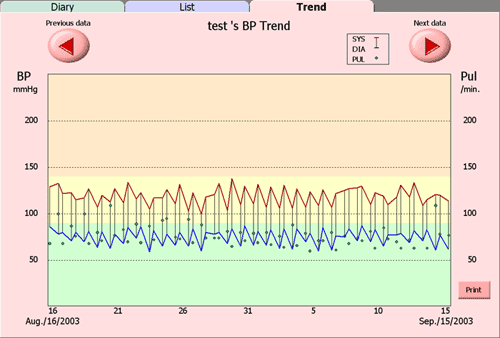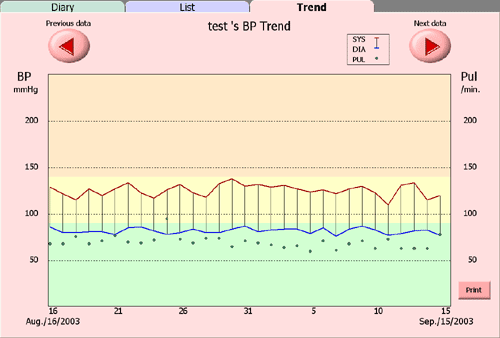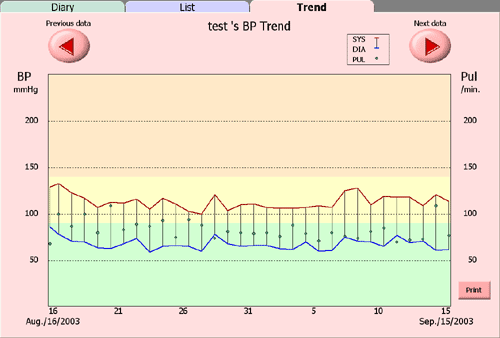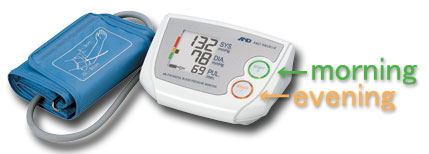 Blood pressure fluctuates. As a supplier of ambulatory blood pressure monitors we know this very well. Interpreting the nature of its fluctuation is one of the most important diagnostic procedures and is still a subject of medical interest in terms of enhancing understanding of the cardiovascular behavior of a human body. However, to a consumer most of the time it only means instability of reading or his body condition at the time of measuring, and does not pose any action for him to take. This may prove to be an unfortunate oversight in the future.
Blood pressure fluctuates. As a supplier of ambulatory blood pressure monitors we know this very well. Interpreting the nature of its fluctuation is one of the most important diagnostic procedures and is still a subject of medical interest in terms of enhancing understanding of the cardiovascular behavior of a human body. However, to a consumer most of the time it only means instability of reading or his body condition at the time of measuring, and does not pose any action for him to take. This may prove to be an unfortunate oversight in the future.
 During the development of the recently launched UA-774 Dual Memory Monitor, we came to realize that it can be a useful tool for a consumer to know his blood pressure and its fluctuation in relation to his normal blood pressure behavior. A consumer can acquire his measurement data in a time-segmented manner when the dual memory is used in a particular way. Let me illustrate what I mean by this.
During the development of the recently launched UA-774 Dual Memory Monitor, we came to realize that it can be a useful tool for a consumer to know his blood pressure and its fluctuation in relation to his normal blood pressure behavior. A consumer can acquire his measurement data in a time-segmented manner when the dual memory is used in a particular way. Let me illustrate what I mean by this.
 While I was wondering how I could prove my point of time segmentation, I fortunately learned that Mr. Ota, manager of our BP design group, rigorously monitors his blood pressure twice a day as he takes anti-hypertensive drugs. Chart I shows his record of measurement data taken for a month, from August 16, 2003 through September 15, 2003. (He has recorded the data for a number of years for his personal benefit as well as to gather data to be used in the development of better algorithm for our blood pressure monitors. The blood pressure monitor his design team develops must satisfy his own need first.).
While I was wondering how I could prove my point of time segmentation, I fortunately learned that Mr. Ota, manager of our BP design group, rigorously monitors his blood pressure twice a day as he takes anti-hypertensive drugs. Chart I shows his record of measurement data taken for a month, from August 16, 2003 through September 15, 2003. (He has recorded the data for a number of years for his personal benefit as well as to gather data to be used in the development of better algorithm for our blood pressure monitors. The blood pressure monitor his design team develops must satisfy his own need first.).

 The upper solid line indicates systolic, and the lower one, diastolic pressure. The dots indicate heart rates. The data fluctuate but show somewhat regular zigzag changes. As Mr. Ota takes drugs every morning at around 7 on workdays and 9 during weekends, and he measures his blood pressure about 30 minutes before he takes the drug in the morning and about 30 minutes after he takes the drug in the evening, one can easily guess the fluctuation relates to the effect of the drug. In order to illustrate this point, I have separated the data into two; one for the data collected in the morning and the other, in the evening. The following two charts show both sets of data; Chart II showing the morning measurement, and Chart III, the evening measurement.
The upper solid line indicates systolic, and the lower one, diastolic pressure. The dots indicate heart rates. The data fluctuate but show somewhat regular zigzag changes. As Mr. Ota takes drugs every morning at around 7 on workdays and 9 during weekends, and he measures his blood pressure about 30 minutes before he takes the drug in the morning and about 30 minutes after he takes the drug in the evening, one can easily guess the fluctuation relates to the effect of the drug. In order to illustrate this point, I have separated the data into two; one for the data collected in the morning and the other, in the evening. The following two charts show both sets of data; Chart II showing the morning measurement, and Chart III, the evening measurement.


 Now, both the charts have few short-term fluctuations but should show long-term fluctuations, if any, so the average of the data makes more sense. The systolic and diastolic averages of the morning and evening data together are 123 over 77. The same averages for the morning data are 130 over 84 while the averages for the evening data are 117 over 69. When averaging the morning data mixed with the evening data, you cannot find or can easily neglect the meaningful difference between the average of the morning data and that of the evening data. Thus, there is a tendency to overlook the long-term fluctuation of the blood pressure, which could be a critical factor in the treatment of hypertensions when viewing all the data as one or taking the averages of all the data regardless of measurement time differences.
Now, both the charts have few short-term fluctuations but should show long-term fluctuations, if any, so the average of the data makes more sense. The systolic and diastolic averages of the morning and evening data together are 123 over 77. The same averages for the morning data are 130 over 84 while the averages for the evening data are 117 over 69. When averaging the morning data mixed with the evening data, you cannot find or can easily neglect the meaningful difference between the average of the morning data and that of the evening data. Thus, there is a tendency to overlook the long-term fluctuation of the blood pressure, which could be a critical factor in the treatment of hypertensions when viewing all the data as one or taking the averages of all the data regardless of measurement time differences.
 Time segmented data can provide an important benefit; however, to a consumer it is too complicated or can even be overkill as analyzing the data only adds a greater mental burden. But now with the new UA-774 Dual Memory Monitor, it can accomplish its purpose in the simplest fashion, which is by using the “Start 1” button for the morning reading and the “Start 2” button for the evening data, for instance. All one has to do is to press Start 1 for the morning measurement and Start 2 for the evening measurement, nothing more.
Time segmented data can provide an important benefit; however, to a consumer it is too complicated or can even be overkill as analyzing the data only adds a greater mental burden. But now with the new UA-774 Dual Memory Monitor, it can accomplish its purpose in the simplest fashion, which is by using the “Start 1” button for the morning reading and the “Start 2” button for the evening data, for instance. All one has to do is to press Start 1 for the morning measurement and Start 2 for the evening measurement, nothing more.
 Ease of use has been one of our most important product concepts ever since we introduced the UA-777 Legendary Monitor. The ease of use to actual users who need to monitor blood pressure for themselves at home and who are over 60 of age has been our theme. In addition to being accurate and reliable, the product must be simple and intuitive in operational procedure. The one-button-operation has been engineered as a result of our constant pursuit for ease of use, though here and there it has to stand criticism in the eye of competitors who bring products with bells and whistles as more functions mean more buttons. However, those added functions mostly come as a result of consumer electronic gadget ideas, not as a product of actual needs of an actual blood pressure monitor user, and are most often irrelevant or even bothersome to serious blood pressure monitor users.
Ease of use has been one of our most important product concepts ever since we introduced the UA-777 Legendary Monitor. The ease of use to actual users who need to monitor blood pressure for themselves at home and who are over 60 of age has been our theme. In addition to being accurate and reliable, the product must be simple and intuitive in operational procedure. The one-button-operation has been engineered as a result of our constant pursuit for ease of use, though here and there it has to stand criticism in the eye of competitors who bring products with bells and whistles as more functions mean more buttons. However, those added functions mostly come as a result of consumer electronic gadget ideas, not as a product of actual needs of an actual blood pressure monitor user, and are most often irrelevant or even bothersome to serious blood pressure monitor users.
 The UA-774 Dual Memory Monitor has been born out of the controversial issue of more functions versus simplicity. At one stage of development the concept of “One-button-operation” appeared to be more of an obstacle than the guiding purpose, but the idea of “This is my button, and that is yours” surfaced and resolved all the issues. It resulted in a monitor of two power switches or buttons that has made it possible to keep our concept of “one-button-operation”. By pressing a button, or “my” button, the monitor switches its power on, shows the average of MY previously measured data, initiates measurement and stores the data in MY memory and finishes - all automatically in one sequence! Once you have chosen which button is yours and which is your partner's, the monitor is identical to the single button monitor. The only difference is that the stored data are segmented according to user; my data and your data.
The UA-774 Dual Memory Monitor has been born out of the controversial issue of more functions versus simplicity. At one stage of development the concept of “One-button-operation” appeared to be more of an obstacle than the guiding purpose, but the idea of “This is my button, and that is yours” surfaced and resolved all the issues. It resulted in a monitor of two power switches or buttons that has made it possible to keep our concept of “one-button-operation”. By pressing a button, or “my” button, the monitor switches its power on, shows the average of MY previously measured data, initiates measurement and stores the data in MY memory and finishes - all automatically in one sequence! Once you have chosen which button is yours and which is your partner's, the monitor is identical to the single button monitor. The only difference is that the stored data are segmented according to user; my data and your data.
 The same two buttons can be used by a single person for collecting time-segmented data. Because of the nature of blood pressure, this time segmentation in its simplest form can be very powerful and meaningful to serious users, to those who are on medication and to the people with borderline hypertension. By time segmentation, a long-term fluctuation, which would otherwise be smeared by the mixture of morning and evening data, can be detected earlier. As I played with Mr. Ota's data, I have come to believe time segmentation will be another powerful and beneficial concept born out of the UA-774 Dual Memory Monitor, which is simple in operation, but truly represents the user-friendliness A&D also places high priority on .
The same two buttons can be used by a single person for collecting time-segmented data. Because of the nature of blood pressure, this time segmentation in its simplest form can be very powerful and meaningful to serious users, to those who are on medication and to the people with borderline hypertension. By time segmentation, a long-term fluctuation, which would otherwise be smeared by the mixture of morning and evening data, can be detected earlier. As I played with Mr. Ota's data, I have come to believe time segmentation will be another powerful and beneficial concept born out of the UA-774 Dual Memory Monitor, which is simple in operation, but truly represents the user-friendliness A&D also places high priority on .

You may address any comments concerning this editorial by email to Mr. Eto
Index of Mr. Eto's other articles

